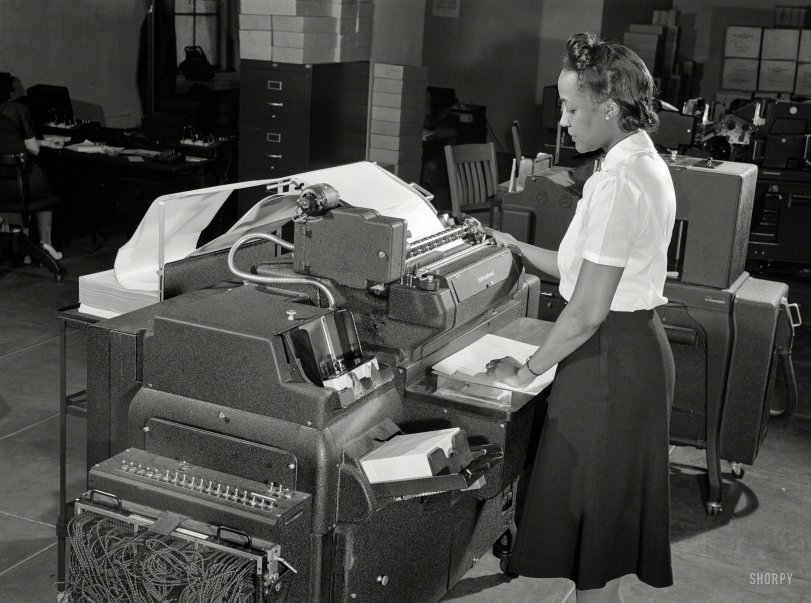


Framed or unframed, desk size to sofa size, printed by us in Arizona and Alabama since 2007. Explore now.
Shorpy is funded by you. Patreon contributors get an ad-free experience.
Learn more.

- Baldwin 62303
- Baldwin VO-1000
- Cold
- No expense spared
- Tough Guys
- Lost in Toyland
- And without gloves
- If I were a blindfolded time traveler
- Smoke Consumer Also Cooks
- Oh that stove!
- Possibly still there?
- What?!?
- $100 Reward
- Freeze Frame
- Texas Flyer wanted
- Just a Year Too Soon
- WWII -- Replacing men with women at the railroad crossing.
- Yes, Icing
- You kids drive me nuts!
- NOT An Easy Job
- I wonder
- Just add window boxes
- Icing Platform?
- Indiana Harbor Belt abides
- Freezing haze
- Corrections (for those who care)
- C&NW at Nelson
- Fallen Flags
- A dangerous job made worse
- Water Stop
Print Emporium
Traffic Channel Control: 1942

June 1942. Washington, D.C. "U.S. Office of Defense Transportation system of port control and its traffic channel control." IBM printer connected to a punch card machine. Photo by Albert Freeman, Office of War Information. View full size.
First came punch cards...
and then came punch card wreaths and stars at Christmas. I wonder how long the cards existed before someone folded them into Christmas decorations.
[Here's an example from 1966. -tterrace]

In the spirit of the season
This reminds me of the last day before Christmas Break in college. Every year this guy would come in to the computer lab and submit a job with three drawers of punch cards. About 30 minutes later, the line printer would start playing Christmas carols. With harmony.
Ear protection?
I wonder, how loud was this contraption in full swing?
It's an IBM 405 alphabetical accounting machine
This machine seems to have been able to process up to 150 cards per minute, or 80 alphanumeric cards per minute. It could make sums of data stored on cards, and print the results on wide paper.
Moving to the machine on the right, it's interesting to note that the frame was made with curved legs, then the machine's rectilinear covers were cut out to fit around the legs.
From Many, One
There is cautionary narrative here for the tyrants of the world.
It is just a few months after the attack on Pearl Harbor and America's entry into World War 2. In Europe and the Orient, the Axis powers and their minions are busily impressing multitudes of subject peoples into slavery, building munitions, roads, fortifications and the like. (And those are the lucky ones -- the ones not starved, gassed and incinerated.)
Yet here in America is this lady -- a civil servant almost certainly the descendant of slaves herself, now the master of this latest arcane and inscrutable mechanism from the International Business Machines Corporation. Calmly overseeing the scheduling of, let's say, the departure of Liberty Ships from their East Coast ports to destinations in England and the Soviet Union.
And thousands more like her, gathering in their makeshift offices across the United States, day after day slowly and methodically planting the seeds of Hitler's doom.
Doing her bit
A competent, assured, and lovely young woman doing a skilled task for the war effort.
What a wonderful contrast to the KKK twit in the previous post. Dave, did you sync 'em up like that on purpose??
It's a tabulator.
Don't know the model number, the ones I worked on were of a later generation.
Data from 80-column punched cards were printed in neat columns on the printer. The plugboard to the left of the machine is used to program which card columns map to the printer character positions, for example: card columns 1 - 10 are printed in positions 20 - 29 on the printer. The ones I worked on could calculate running, intermediate and grand totals for specified card fields and also print running page and column headers.
In the early 1960s the functions of this sort of machine were taken over by the newer, cheaper IBM mainframes (1400 series, for example) using the RPG program. RPG was basically a report generator program which allowed the mainframe to emulate a card tabulator and sorter.
I dare say there are still some older IBM sites running ROG programs under some sort of emulation.
Precious memories
Notice the toggle switch on the tray receiving the processed cards. If too many cards come from the hopper above, the steel plate in front of the cards will nudge the toggle switch to "Off" and shut the machine down. I was running a job on a variant (IBM 402) of the machine pictured one afternoon in the railroad yard office I worked in. I was making small talk with a train conductor while running the job, and the phone rang at the other end of the office. I took the call as I watched the conductor bid me farewell with a wave, and went back to the printer. It was dead. I tried a few tricks I knew and finally gave up, calling for a service rep from IBM. The guy came in and never opened his tool kit. He walked over to the printer, looked me straight in the eye, and flipped the toggle switch to "On." Then he sat down and did his paperwork, never uttering a word all the time he was there. Never knew I could feel so small. The conductor had turned the switch to "Off" while I was on the phone. A week or two later it was my turn. Paybacks are sweet.
The frame at the end with the mini entrails is the program. Our office had about five or six of these things hanging on the wall, each one for a particular job.
Back when you could see the bits
This mechanical computing machinery helps us to see how far we've come in the last 70 years. Every bit of data is big enough to see on the punch cards, and every signal path is visible on the programming plugboard.
Yet, somehow, they used this stuff to get the job done.
























On Shorpy:
Today’s Top 5